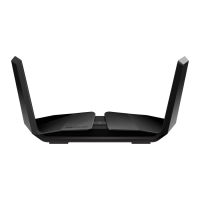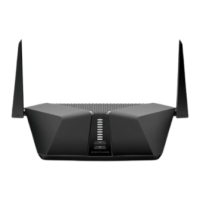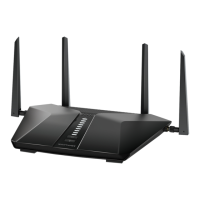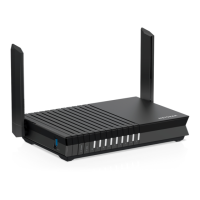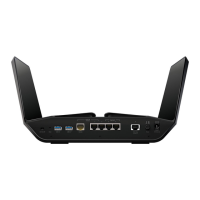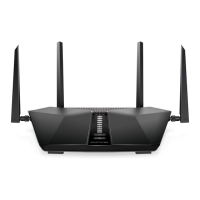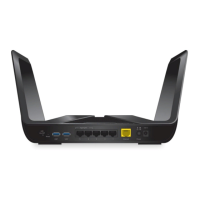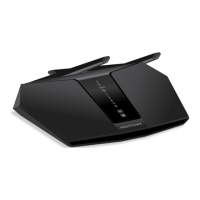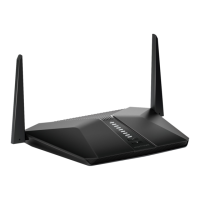Do you have a question about the NETGEAR RAX120 and is the answer not in the manual?
Instructions on unboxing the router, power adapter, and Ethernet cable.
Details the status LEDs and buttons on the router's top panel and their functions.
Identifies connectors and buttons located on the rear panel of the router.
Guidance on how to position and extend the router's antennas for optimal placement.
Information about the router label, which contains login details and serial numbers.
Recommendations for placing the router for optimal WiFi network coverage and performance.
Steps to connect the router to a modem and power source.
Instructions on how to control the router's LED indicator lights using the rear panel switch.
Explains how to establish a wired or WiFi connection to the router.
Defines different login types, including ISP, WiFi, and router admin logins.
Guides users on accessing the router's web interface for configuration and settings.
Details the automatic process for setting up the router's Internet connection.
Steps to log in to the router's web interface using admin credentials.
Instructions for installing and using the Nighthawk mobile app for router management.
Procedure for changing the display language of the router's web interface.
Overview of managing router settings and features via the Nighthawk mobile application.
Walkthrough of the setup wizard to automatically configure Internet settings.
Steps for manually configuring the router's Internet connection settings.
Guide on setting up the router for IPv6 Internet connectivity.
Explains how to adjust the Maximum Transmission Unit (MTU) size for network performance.
Configures access control rules to permit or deny devices on the network.
Enables blocking specific websites by entering keywords or domain names.
Allows blocking of specific Internet services or applications based on protocols and ports.
Manages lists of allowed and blocked devices to control network access.
Sets schedules for blocking specific websites or services.
Configures email alerts for security events and router activity logs.
Configures Quality of Service (QoS) to prioritize streaming applications for better performance.
Enables UPnP for automatic device configuration and improved network connectivity.
Controls WMM QoS settings to prioritize WiFi voice and video traffic.
Manages Smart Connect feature to automatically select the best WiFi band for devices.
Controls the enabling or disabling of AX WiFi features for improved network capacity.
Configures Wide Area Network (WAN) settings for Internet connectivity.
Configures a DMZ server to allow specific traffic to bypass firewall protection.
Allows renaming the router for easier identification on the network.
Modifies the router's Local Area Network (LAN) IP address and subnet mask.
Defines the range of IP addresses the router's DHCP server assigns to network devices.
Turns off the router's DHCP server, allowing another device to manage IP assignments.
Assigns static IP addresses to specific devices on the local network.
Simplifies WiFi connection by using the WPS button or PIN method.
Configures fundamental WiFi settings like SSID, security, and region.
Updates the WiFi network password and selects security encryption protocols.
Adjusts the WiFi operational mode (e.g., speed, compatibility) for different bands.
Creates a separate WiFi network for guests, isolating them from the main network.
Enables or disables the router's WiFi radios for power saving or security.
Schedules times for automatically turning WiFi signal on or off.
Configures the router to function as a WiFi Access Point (AP) in an existing network.
Sets the router to bridge mode to extend WiFi coverage wirelessly.
Configures bridges for specific port groups or VLAN tags, often for IPTV.
Defines manual static routes for specific network traffic forwarding.
Combines multiple Ethernet ports to increase file transfer speed.
Checks for and installs the latest firmware updates for the router.
Instructions for changing the router's administrative login password for security.
Sets up security questions to facilitate password recovery if forgotten.
Steps to recover the router's admin password using previously set security questions.
Displays general router status, Internet connection, and WiFi network information.
Shows detailed statistics for the router's WAN and LAN ports, including traffic data.
Verifies the current status of the router's Internet connection and IP configuration.
Accesses and reviews detailed logs of router activities and security events.
Lists all devices currently connected to the router's network, showing their IP and MAC addresses.
Tracks and controls internet data volume and connection time usage.
Backs up, restores, or erases router configuration settings.
Enables and configures access to the router's settings over the Internet.
Customizes router LED behavior, including disabling blinking or turning off all LEDs.
Lists requirements for USB storage devices, including supported file systems and compatibility.
Step-by-step guide for physically connecting a USB storage device to the router.
Instructions for accessing USB storage from a Windows computer via the network.
Steps to map a USB storage device as a network drive in Windows for easy access.
Instructions for accessing USB storage from a Mac computer via the network.
Utilizes ReadySHARE Vault software for automatic backup of Windows computers.
Guides on using Time Machine for backing up Mac computers to a connected USB drive.
Configures the router to allow FTP access to USB storage devices on the local network.
Manages network folder shares on connected USB storage devices.
Creates new network folders on a USB storage device for sharing.
Modifies settings for existing network folders on USB storage devices.
Procedure for safely disconnecting a USB storage device from the router.
Configures Dynamic DNS service to access the router and connected devices remotely.
Enables FTP access to USB storage devices over the Internet.
Guides on setting up a personal FTP server using Dynamic DNS for remote access.
Steps to create a new NETGEAR Dynamic DNS account for remote access.
Configures the router to use an existing Dynamic DNS account from supported providers.
Modifies settings for an existing Dynamic DNS account configuration.
Explains how to access USB storage devices connected to the router over the Internet.
Utilizes ReadyCLOUD for remote access to files stored on USB devices via the cloud.
Guides on creating a ReadyCLOUD account for remote file access.
Links the router to a ReadyCLOUD account for remote management and access.
Establishes a secure Virtual Private Network (VPN) connection to the router.
Configures the router to enable and manage VPN service settings.
Provides instructions for installing OpenVPN client software on various devices.
Details on establishing a VPN tunnel from a Windows computer to the router.
Accesses USB storage and media files on the router via a VPN connection.
Connects to home Internet service remotely using a VPN connection.
Configures the router to allow VPN clients to use the home Internet connection.
Restricts VPN clients from accessing the Internet, allowing only home network access.
Configures rules to forward incoming Internet traffic to specific local servers.
Adds custom port forwarding rules for applications not predefined in the router.
Modifies existing port forwarding rules for services or applications.
Removes specific port forwarding rules from the router configuration.
Explains port triggering, a dynamic method for managing incoming traffic based on outgoing traffic.
Creates new port triggering rules for services that require dynamic port opening.
Activates the port triggering feature, allowing dynamic port management.
Provides general tips for resolving common router problems.
Correct order for restarting modem and router to resolve network issues.
Verifies secure and correct physical connections of Ethernet cables.
Ensures WiFi settings on devices match the router's configuration.
Confirms correct IP addressing and DHCP configuration on computers.
Interprets router LED status indicators to diagnose problems.
Troubleshooting steps if unable to access the router's web interface.
Diagnoses issues preventing the router or connected devices from accessing the Internet.
Resolves problems with loading web pages or accessing online content.
Troubleshoots issues where router configuration changes are not applied or saved.
Diagnoses and resolves problems with connecting devices to the WiFi network.
Uses the ping utility to test network path connectivity and diagnose issues.
Details the default factory settings of the router and how to restore them.
Provides detailed technical specifications for the router, including hardware and protocols.
Instructions on unboxing the router, power adapter, and Ethernet cable.
Details the status LEDs and buttons on the router's top panel and their functions.
Identifies connectors and buttons located on the rear panel of the router.
Guidance on how to position and extend the router's antennas for optimal placement.
Information about the router label, which contains login details and serial numbers.
Recommendations for placing the router for optimal WiFi network coverage and performance.
Steps to connect the router to a modem and power source.
Instructions on how to control the router's LED indicator lights using the rear panel switch.
Explains how to establish a wired or WiFi connection to the router.
Defines different login types, including ISP, WiFi, and router admin logins.
Guides users on accessing the router's web interface for configuration and settings.
Details the automatic process for setting up the router's Internet connection.
Steps to log in to the router's web interface using admin credentials.
Instructions for installing and using the Nighthawk mobile app for router management.
Procedure for changing the display language of the router's web interface.
Overview of managing router settings and features via the Nighthawk mobile application.
Walkthrough of the setup wizard to automatically configure Internet settings.
Steps for manually configuring the router's Internet connection settings.
Guide on setting up the router for IPv6 Internet connectivity.
Explains how to adjust the Maximum Transmission Unit (MTU) size for network performance.
Configures access control rules to permit or deny devices on the network.
Enables blocking specific websites by entering keywords or domain names.
Allows blocking of specific Internet services or applications based on protocols and ports.
Manages lists of allowed and blocked devices to control network access.
Sets schedules for blocking specific websites or services.
Configures email alerts for security events and router activity logs.
Configures Quality of Service (QoS) to prioritize streaming applications for better performance.
Enables UPnP for automatic device configuration and improved network connectivity.
Controls WMM QoS settings to prioritize WiFi voice and video traffic.
Manages Smart Connect feature to automatically select the best WiFi band for devices.
Controls the enabling or disabling of AX WiFi features for improved network capacity.
Configures Wide Area Network (WAN) settings for Internet connectivity.
Configures a DMZ server to allow specific traffic to bypass firewall protection.
Allows renaming the router for easier identification on the network.
Modifies the router's Local Area Network (LAN) IP address and subnet mask.
Defines the range of IP addresses the router's DHCP server assigns to network devices.
Turns off the router's DHCP server, allowing another device to manage IP assignments.
Assigns static IP addresses to specific devices on the local network.
Simplifies WiFi connection by using the WPS button or PIN method.
Configures fundamental WiFi settings like SSID, security, and region.
Updates the WiFi network password and selects security encryption protocols.
Adjusts the WiFi operational mode (e.g., speed, compatibility) for different bands.
Creates a separate WiFi network for guests, isolating them from the main network.
Enables or disables the router's WiFi radios for power saving or security.
Schedules times for automatically turning WiFi signal on or off.
Configures the router to function as a WiFi Access Point (AP) in an existing network.
Sets the router to bridge mode to extend WiFi coverage wirelessly.
Configures bridges for specific port groups or VLAN tags, often for IPTV.
Defines manual static routes for specific network traffic forwarding.
Combines multiple Ethernet ports to increase file transfer speed.
Checks for and installs the latest firmware updates for the router.
Instructions for changing the router's administrative login password for security.
Sets up security questions to facilitate password recovery if forgotten.
Steps to recover the router's admin password using previously set security questions.
Displays general router status, Internet connection, and WiFi network information.
Shows detailed statistics for the router's WAN and LAN ports, including traffic data.
Verifies the current status of the router's Internet connection and IP configuration.
Accesses and reviews detailed logs of router activities and security events.
Lists all devices currently connected to the router's network, showing their IP and MAC addresses.
Tracks and controls internet data volume and connection time usage.
Backs up, restores, or erases router configuration settings.
Enables and configures access to the router's settings over the Internet.
Customizes router LED behavior, including disabling blinking or turning off all LEDs.
Lists requirements for USB storage devices, including supported file systems and compatibility.
Step-by-step guide for physically connecting a USB storage device to the router.
Instructions for accessing USB storage from a Windows computer via the network.
Steps to map a USB storage device as a network drive in Windows for easy access.
Instructions for accessing USB storage from a Mac computer via the network.
Utilizes ReadySHARE Vault software for automatic backup of Windows computers.
Guides on using Time Machine for backing up Mac computers to a connected USB drive.
Configures the router to allow FTP access to USB storage devices on the local network.
Manages network folder shares on connected USB storage devices.
Creates new network folders on a USB storage device for sharing.
Modifies settings for existing network folders on USB storage devices.
Procedure for safely disconnecting a USB storage device from the router.
Configures Dynamic DNS service to access the router and connected devices remotely.
Enables FTP access to USB storage devices over the Internet.
Guides on setting up a personal FTP server using Dynamic DNS for remote access.
Steps to create a new NETGEAR Dynamic DNS account for remote access.
Configures the router to use an existing Dynamic DNS account from supported providers.
Modifies settings for an existing Dynamic DNS account configuration.
Explains how to access USB storage devices connected to the router over the Internet.
Utilizes ReadyCLOUD for remote access to files stored on USB devices via the cloud.
Guides on creating a ReadyCLOUD account for remote file access.
Links the router to a ReadyCLOUD account for remote management and access.
Establishes a secure Virtual Private Network (VPN) connection to the router.
Configures the router to enable and manage VPN service settings.
Provides instructions for installing OpenVPN client software on various devices.
Details on establishing a VPN tunnel from a Windows computer to the router.
Accesses USB storage and media files on the router via a VPN connection.
Connects to home Internet service remotely using a VPN connection.
Configures the router to allow VPN clients to use the home Internet connection.
Restricts VPN clients from accessing the Internet, allowing only home network access.
Configures rules to forward incoming Internet traffic to specific local servers.
Adds custom port forwarding rules for applications not predefined in the router.
Modifies existing port forwarding rules for services or applications.
Removes specific port forwarding rules from the router configuration.
Explains port triggering, a dynamic method for managing incoming traffic based on outgoing traffic.
Creates new port triggering rules for services that require dynamic port opening.
Activates the port triggering feature, allowing dynamic port management.
Provides general tips for resolving common router problems.
Correct order for restarting modem and router to resolve network issues.
Verifies secure and correct physical connections of Ethernet cables.
Ensures WiFi settings on devices match the router's configuration.
Confirms correct IP addressing and DHCP configuration on computers.
Interprets router LED status indicators to diagnose problems.
Troubleshooting steps if unable to access the router's web interface.
Diagnoses issues preventing the router or connected devices from accessing the Internet.
Resolves problems with loading web pages or accessing online content.
Troubleshoots issues where router configuration changes are not applied or saved.
Diagnoses and resolves problems with connecting devices to the WiFi network.
Uses the ping utility to test network path connectivity and diagnose issues.
Details the default factory settings of the router and how to restore them.
Provides detailed technical specifications for the router, including hardware and protocols.
| WiFi Standard | 802.11ax |
|---|---|
| WiFi Range | Very large homes |
| Processor | 1.8GHz Quad-Core |
| MU-MIMO | Yes |
| Beamforming | Yes |
| USB Ports | 2 x USB 3.0 |
| Memory | 512MB NAND Flash and 1GB RAM |
| WiFi Technology | Dual-Band WiFi 6 (802.11ax) |
| Antennas | 8 high-performance internal antennas |
